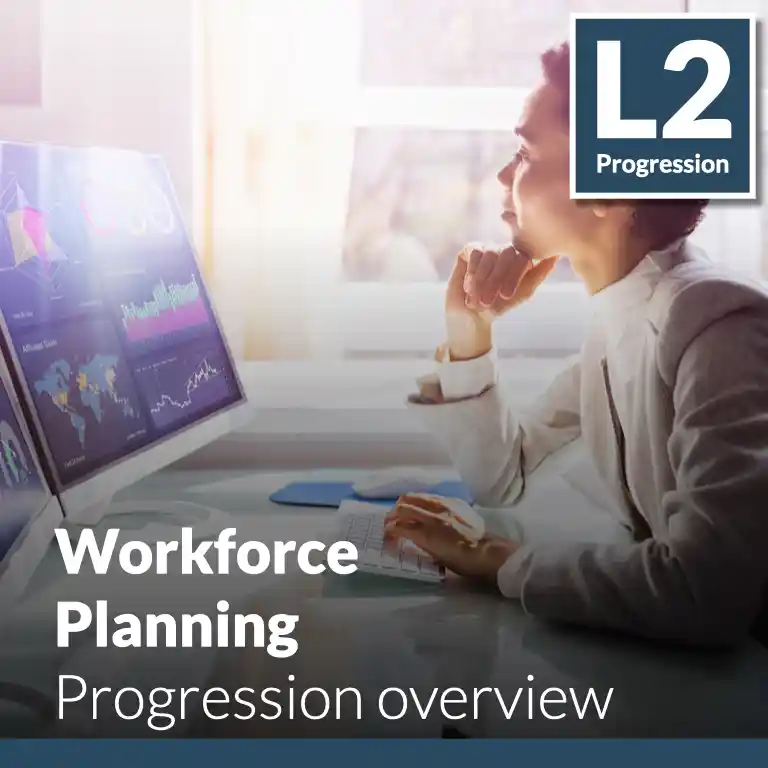Enjoy instant access to a scalable system of proven practices and execution-ready tools. Built to launch strategic HR programs 5X faster!
✓ Enjoy platform access
✓ Create your HR roadmap
✓ View open content in library
✓ Access dozens of practices:
⤷ The HR Strategy program
⤷ Explainers and deep dives
⤷ Supplemental guides
⤷ Insight articles
⤷ Weekly best practices
⤷ And more!
100% Free. No credit card required.
This guide is part of a progression set comprised of Core, Advanced, and Emerging workforce planning practices.
Advanced workforce planning practices help evaluate and make projections of employee supply and demand at a role level, creating a more refined view of talent needs and availability. They consider the relative strategic value of the range of positions/roles through the lens of the linkage between each one’s primary function and the company’s strategic objectives, plus the difficulty in replacing those in the relevant labor markets. They act to quantify the availability and location of future candidates by engaging external databases of supply/availability assessments, providing clarity as to the challenges (or lack thereof) of hiring new and replacement employees by position or job role in both near- and long-term timeframes.
These further clarify the staffing requirements and subsequent plans by segmenting the workforce into groupings based on their criticality to future strategies and scarcity in the marketplace. Such segmentation enables a more nuanced and specific gap analysis to prioritize mitigation efforts. Generating detailed insights into the types and volumes of employees required creates a better-informed picture of what is needed and the timeframes within which the resources are required. This level of analysis and planning also broadens the options for building a long-term strategy beyond recruiting and short-term training with multiple methods and sources to fulfill staffing needs over a period of time. It considers not only the hiring of full-time employees but also the retention of the most valued resources and the use of temporary or contingent workforces to supplement more traditional hiring strategies.
A more specific job-level planning assessment provides the superior information needed to optimize the organization's staffing, from key, prioritized roles to those that can be best filled with contractors or temporary employees. It engages all staffing considerations, including the planned development and mobility of existing employees over time, retention strategies for critical workforce segments, and outsourcing less critical, more easily recruited headcount. It creates a greater strategic mix of employment options, including the planned obsolescence of certain jobs or functions through workflow automation.
Such planning efforts involve using reliable and readily available data sources that support highly quantifiable estimates of talent availability from current and future viewpoints. Such databases can provide current employment data by profession/trade/industry/skill-family, experience/job level, location or region, etc. To support the future planning aspect of such an exercise, composite data is available on education pipelines, which offer insights into the scale and timeframes of future availability by educational level, skill family, academic major, or career field.
The process enables more precise workforce cost planning with better forecasting of location, space, benefits, and changes in staff support requirements. Long-term talent management planning and staffing are supported by more rational, accurate, proactive thinking and action preparation. It creates the foundation for more objectively based discussions and decision support around staffing and staff development plans, understanding the barriers to future success, and developing strategies and tactics needed to ensure the ability to meet future demands.
Developing an advanced workforce planning capability yields a much more refined set of projections of workforce requirements that support an increasingly objective view of future staffing profiles across the enterprise. It involves conducting a deep dive into the relative value of an organization's roles, focusing on identifying the positions that most significantly contribute to business success. Such an analysis enables the targeting of a disproportionate amount of financial and people resources towards hiring, developing, and retaining workers who contribute the greatest impact on achieving an organization’s critical strategic goals. It provides invaluable insights into the availability and sources of the talent needed to maintain staffing levels in those most-valued candidate pools. It delivers quantitative data on the nature and size of the gaps to be filled. Lastly, it creates detailed plans designed to close those gaps that can be used to guide subsequent hiring, development, engagement, and retention efforts.
Generating a view of the positions that have a disproportionate impact on meeting key strategic objectives across the organization.
Utilizing external data to determine current and future availability of the talent needed to fulfill the company’s strategic objectives.
Identifying where shortages will likely exist in critical talent roles and providing the basis for replacement planning well in advance of the future loss of individuals in those positions.
Defining specialized and concentrated efforts that will be undertaken for the key roles with greatest importance to meeting the organization’s strategic objectives.

Enjoy instant access to a scalable system of proven practices and execution-ready tools. Built to launch strategic HR programs 5X faster!